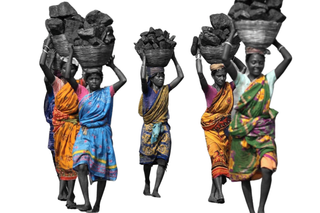
ILO Report Shows Indians Are the Most Overworked Globally, and Among the Worst Paid in Asia
India’s minimum wages are also the lowest in the world.

Indian workers are clocking in some of the longest hours across the globe but are compensated inordinately, a recent report by the International Labour Organisation (ILO) shows. This pegs the minimum statutory wage of an Indian worker to be the lowest in the world, barring a few sub-Saharan African countries.
Titled “Global Wage Report 2020-21: Wages and Minimum Wages in the Time of COVID-19,” the report was released earlier this week, capturing the impact of the pandemic on labor compensation globally. The data taps into official estimates issued by government agencies from 2019, and also takes into account earlier statistics for other countries.
ILO found that work hours in India can stretch up to 48 hours per week, a phenomenon that makes India among the top five in long working hours. It is surpassed only by Gambia, Maldives, Mongolia, and Qatar.
When compared globally, an average worker in China puts in 46 hours a week, followed by 37 hours in the U.S., and 36 hours in the U.K. and Israel. The ILO report notes a caveat that the actual wage could differ in the case of the informal sector and other blue-collar workers.
Curiously, in the years preceding the Covid19 crisis, the Asia-Pacific region witnessed the highest real wage growth globally between 2006 and 2019. India — along with China, the Republic of Korea, and other countries — registered a rapid rise in real wages. The pandemic, however, has offset much of this progress. Wages for formal workers were cut by almost 3.6% while informal workers experienced a sharper decline of 22.6%, according to a study.
Related on The Swaddle:
Bosses Who Are Men View Employees’ Depression More Negatively Than Women Bosses: Study
“If economies are to return to a path towards sustained and balanced economic growth, wage developments will need to take into account the need both for incomes and aggregate demand to be supported and for enterprises to remain successful and sustainable,” ILO chief Guy Ryder notes in the preface to the report.
ILO’s India findings also make use of data from the Periodic Labour Force Survey (PLFS) conducted by the National Statistical Office from July 2018 to June 2019. At the outset, it was found that well-heeled urban employees in India worked longer than those in a rural setting. A gendered analysis also revealed that men worked more than women in rural and urban areas.
The PLFS survey estimated work hours across both urban and rural areas and categorizes workers as self-employed, regular wage and salaried, and casual employees. In urban areas, self-employed men were found to be working for an average of 55 hours per week, regular employees worked for 53, and casual labor registered 45 hours. Self-employed women clocked in 39 hours, salaried employees a total of 46 hours, and women engaged in casual labor spent 38 hours.
In rural India, men earning regular wages and salaries work for 52 hours a week, those doing casual labor toiled for 45 hours, and self-employed men worked for 48 hours. In comparison to this, self-employed women work for 37 hours every week, salaried women work for 44, and female casual laborers spend 39 hours working.
In 2020, India revealed the data of its time-use survey, an exercise conducted for the first time in 20 years, to map out the participation of men, women and other groups in paid and unpaid labor. Conducted by the Ministry of Statistics and Programme Implementation, it found that women undertook a large chunk of unpaid labor as compared to men. The survey also found that Indians spend less than one-tenth of time in a day for leisure, and especially women get far less time than men for leisure.
The ILO findings and other national data around labor participation offer little context around why people participate in certain activities, and the socio-cultural factors determining their engagement. But these statistics assume importance, as India prepares to introduce four new labor codes soon. The new guidelines will allow companies to opt for four-day workweeks while keeping the total number of working hours the same (at 48), effectively translating into 12-hour shifts every day. The regulations around fixed working hours and labor codes target only the formal workforce. For over 90% of India’s workforce who are employed in the informal sector (roughly 400 million people), this proposal would thus hold little weight.
The data, as well as proposed policy changes, do not factor in logistical factors such as commuting to and from work and the evolving nature of modern employment that spills beyond office hours. But an airtight conclusion can be suitably drawn from ILO figures and supporting evidence that a majority of Indians are not adequately paid for their considerable amount of labor. Setting a just minimum wage that applies to the formal and informal sector is largely believed to be a building block towards greater social justice and bridging inequality.
Saumya Kalia is an Associate Editor at The Swaddle. Her journalism and writing explore issues of social justice, digital sub-cultures, media ecosystem, literature, and memory as they cut across socio-cultural periods. You can reach her at @Saumya_Kalia.
Related


Women‑Led Governments Are More Likely to Deliver on Campaign Promises: Multi‑Country Study
